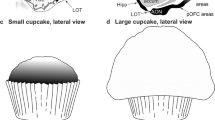Abstract
Studies of the pedunculopontinopallidal projections of the dog brain based on the retrograde axonal transport of horseradish peroxidase demonstrated that the compact zone (PPNc) and the lateral area of the diffuse zone (PPNd) of the pedunculopontine tegmental nucleus (PPN) of the midbrain project to the globus pallidus, entopeduncular nucleus, and ventral pallidum. The medial area of the PPNd, adjacent to the chiasm of the upper cerebellar peduncles and seen in other animals as the mesencephalic extrapyramidal area (MEA), projects only to the globus pallidus. In dogs, this area of the tegmentum is not a major source of projections to the striopallidum, such that it is inappropriate to regard it as a separate structure, comment being restricted to the topical organization of PPNd projections to the pallidum. Projection fibers to pallidal structures arise from both cholinergic and non-cholinergic PPN neurons.
Similar content being viewed by others
References
A. I. Gorbachevskaya and O. G. Chivileva, “Morphological analysis of information conduction pathways in the basal ganglia of mammals,” Usp. Fiziol. Nauk., 34, No. 2, 45–63 (2003).
A. I. Gorbachevskaya and O. G. Chivileva, “Structural organization of the tegmental pedunculopontine nucleus of the midbrain in dogs,” Morfologiya, 126, No. 5, 11–15 (2004).
O. G. Chivileva and A. I. Gorbachevskaya, “Organization of the efferent projections of the tegmental pedunculopontine nucleus to the striatum in the dog brain,” Morfologiya, 126, No. 6, 11–15 (2004).
G. E. Alexander, M. E. DeLong, and P. L. Strick, “Parallel organization of functionally segregated circuits linking basal ganglia and cortex,” Ann. Rev. Neurosci., 9, 357–381 (1986).
M. Crutcher, R. Turner, J. Perez, and D. Rye, “Relationship of the primate pedunculopontine nucleus (PPN) to tegmental connections with the internal pallidum (GPi),” Soc. Neurosci. Abstr., 20, 334 (1994).
S. Dua-Sharma, K. N. Sharma, and H. L. Jacobs, The Canine Brain in Stereotaxic Coordinates, MIT Press, Cambridge (Massachusetts), London (England) (1970).
E. Erro, J. L. Lanciego, and J. M. Gimenez-Ayala, “Relationships between thalamostriatal neurons and pedunculopontine projections to the thalamus: a neuroanatomical tract-tracing study in the rat,” Exptl. Brain Res., 127, No. 2, 162–170 (1999).
S. N. Haber, E. Lynd-Balta, and W. P. J. M. Spooren, “Integrative aspects of basal ganglia circuitry,” in: The Basal Ganglia IV: New Ideas and Data on Structure and Function, Plenum Press, New York (1994), pp. 71–80.
D. Joel and I. Weiner, “The connections of the primate subthalamic nucleus: indirect pathways and the open-interconnected scheme of basal ganglia-thalamocortical circuitry,” Brain Res. Rev., 23, No. 1, 62–78 (1997).
G. L. Keating and D. B. Rye, “Functional organization of the brainstem-basal ganglia interactions as viewed from the pedunculopontine region,” in: Basal Ganglia and Thalamus in Health and Movement Disorders, Kluwer Academic/Plenum Press, New York, Boston, Dordrecht, London, Moscow (2001), pp. 175–188.
Y. Y. Lai, J. R. Clements, and J. M. Siegel, “Brainstem projections to the ventromedial medulla in cat: retrograde transport of horseradish peroxidase and immunohistochemical studies,” J. Comp. Neurol., 408, No. 3, 419–436 (1999).
B. Lavoie and A. Parent, “Pedunculopontine nucleus in the squirrel monkey: projections to the basal ganglia as revealed by anterograde tract-tracing methods,” J. Comp. Neurol., 344, No. 2, 210–231 (1994).
M. Matsumura, A. Nambu, Y. Yamaji, et al., “Organization of somatic motor inputs from the frontal lobe to the pedunculopontine tegmental nucleus in the macaque monkey,” Neurosci., 98, No. 1, 97–110 (2000).
J. J. Mena-Segovia, J. P. Bolam, and P. J. Magill, “Pedunculopontine nucleus and basal ganglia: distant relatives or part of the same family?” Trends Neurosci., 27, No. 10, 585–588 (2004).
M. M. Mesulam, “Tetramethyl benzidine for horseradish peroxidase neurohistochemistry: a non-carcinogenic blue reaction product with superior sensitivity for visualizing neural afferents and efferents,” J. Histochem. Cytochem., 26, No. 2, 106–117 (1978).
A. Parent, Comparative Neurobiology of the Basal Ganglia, A Wiley-Interscience publication, New York (1986).
A. Parent, “Extrinsic connections of the basal ganglia,” Trends, Neurosci., 13, No. 7, 254–258 (1990).
D. B. Rye, C. B. Saper, H. J. Lee, and B. H. Wainer, “Pedunculopontine tegmental nucleus of the rat: cytoarchitecture, cytochemistry, and some extrapyramidal connections of the mesopontine tegmentum,” J. Comp. Neurol., 259, No. 4, 483–528 (1987).
Y. Smith and E. Shink, “The pedunculopontine nucleus (PPN): a potential target for the convergence of information arising from different functional territories of the internal pallidum,” Soc. Neurosci. Abstr., 21, 677 (1995).
B. M. Spann and I. Grofova, “Origin of ascending and spinal pathways from the nucleus tegmenti pedunculopontinus in the rat,” J. Comp. Neurol., 283, No. 1, 13–27 (1989).
K. Takakusaki, T. Habaguchi, J. Ohtinata-Sugimoto, et al., “Basal ganglia efferents to the brainstem centers controlling postural muscle tone and locomotion: a new concept for understanding motor disorders in basal ganglia dysfunction,” Neurosci., 119, No. 1, 293–308 (2003).
S. R. Vincent, K. Satoch, D. M. Armstrong, et al., “NADPH-diaphorase: a selective histochemical marker for the cholinergic neurons of the pontine reticular formation,” Neurosci. Lett., 43, No. 1, 31–36 (1983).
Author information
Authors and Affiliations
Additional information
__________
Translated from Morfologiya, Vol. 127, No. 2, pp. 19–23, March–April, 2005.
Rights and permissions
About this article
Cite this article
Gorbachevskaya, A.I., Chivileva, O.G. Organization of the efferent projections of the pedunculopontine tegmental nucleus of the midbrain of the dog pallidum. Neurosci Behav Physiol 36, 423–428 (2006). https://doi.org/10.1007/s11055-006-0035-7
Received:
Issue Date:
DOI: https://doi.org/10.1007/s11055-006-0035-7




